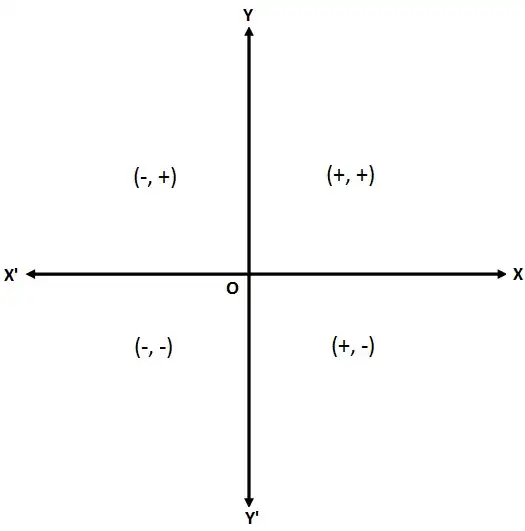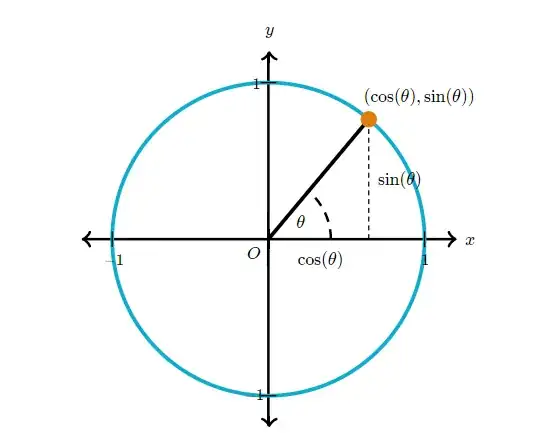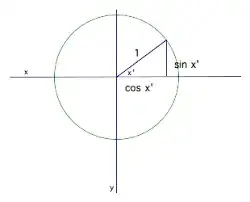Why is the value of $\sin (\theta)$ and $\csc(\theta)$ positive in the second quadrant? Similarly why the value of other trigonometric ratios so in other quadrants?
-
This answer of mine may (or may not) be helpful. – Blue Jan 17 '21 at 03:30
4 Answers
The reason is that the sine is the projection of the point on the trigonometric circle with curvilinear abscissa $\theta$. As to the cosecant, it is the reciprocal of the sine.
- 175,478
First of all note that the cosecant is just $\frac{1}{\sin\theta}$, so they are both positive or both negative.
In the second you can view the sin of $\theta$ as the value of the vertical segment that is perpendicular to the $X$ axis drawn from the point where the radios of angle $\theta$ cuts the unit circle, as the figure shows:
Thus, sine is positive in the first two quadrants, but negative in the last two.
- 462
You may recall this image:

Now, the unit circle definition tells us that $\cos \theta$ and $\sin\theta$ are the $x$ and $y$ coordinates of the point whose radius makes angle $\theta$ with the positive $x$-axis.
Therefore, in the first quadrant ($0<\theta<90^\circ$), both $\cos\theta$ and $\sin\theta$ are positive, and in the second quadrant ($90^\circ<\theta<180^\circ$), $\cos\theta$ is negative and $\sin\theta$ is positive, and so on for third and fourth quadrants.
Define: $$\sec\theta=\frac{1}{\cos\theta}\text{ and }\csc\theta=\frac{1}{\sin\theta}$$ Thus, the sign of $\sec\theta$ is the same as $\cos\theta$ and the sign of $\csc\theta$ is the same as $\sin\theta$.
Define: $$\tan\theta=\frac{\sin\theta}{\cos\theta}\text{ and }\cot\theta=\frac{\cos\theta}{\sin\theta}$$ Thus, the signs of $\tan\theta$ and $\cot\theta$ are positive, if $\sin\theta$ and $\cos\theta$ have same signs, and negative, if different.
For example, for the second quadrant, $\cos\theta$ is negative and $\sin\theta$ is positive. So, $\sec\theta$ is negative and $\csc\theta$ is positive, and , $\tan\theta$ and $\cot\theta$ are negative.
Hope this helps. Ask anything if not clear :)
- 4,245
That's because cartesian coordinate system is defined in that way. This needs explanation, I know.
We have generalised trigonometry, from only inputs between $0$ and $90$ to any real number $\theta$, by using a unit circle (Wikipedia link) on cartesian coordinate system with its centre on origin i.e. $(0,0)$.
To do this generalisation we define $\sin (\theta)$ as $y-axis$ of the the end of the point on radius of that unit circle (Khan Academy link). Now it is by definition that in $2nd$ and $1st$ quadrant $y-coordinate$ is positive, so clearly it follows that $sine$ function must be positive in $2nd$ and $1st$quadrant as it is $y-axis$. Now since $\sin (\theta)$ is positive, so must be $\csc(\theta)$. As we have defined it as reciprocal of $\sin (\theta)$, now reciprocal of any positive number must be a positive number($0$ is not positive).
Now we have similarly defined $\cos(\theta)$ as the $x-coordinate$ of the the end of the point on radius of that unit circle, similarly it must be positive in $1st$ and $4rth$ quadrant.
Following image may be helpful:

It is left as an exercise for you to find why other trigonometric functions ..... you understand what I mean(right)!
-
You mean $y$-coordinate for $\sin\theta$ and $x$-coordinate for $\cos\theta$. – N. F. Taussig Jan 17 '21 at 09:35
-
@ N. F. Taussig Yes?.... I dont understand what you mean by that statement. If you are asking for clarification that if the sinθ and cosθ are defined as y -coordinate and x-coordinate respectively then the answer is Yes. – Jan 17 '21 at 11:41
-
What I am saying is that you should replace $y$-axis by $y$-coordinate and $x$-axis by $x$-coordinate. – N. F. Taussig Jan 17 '21 at 12:06
-
